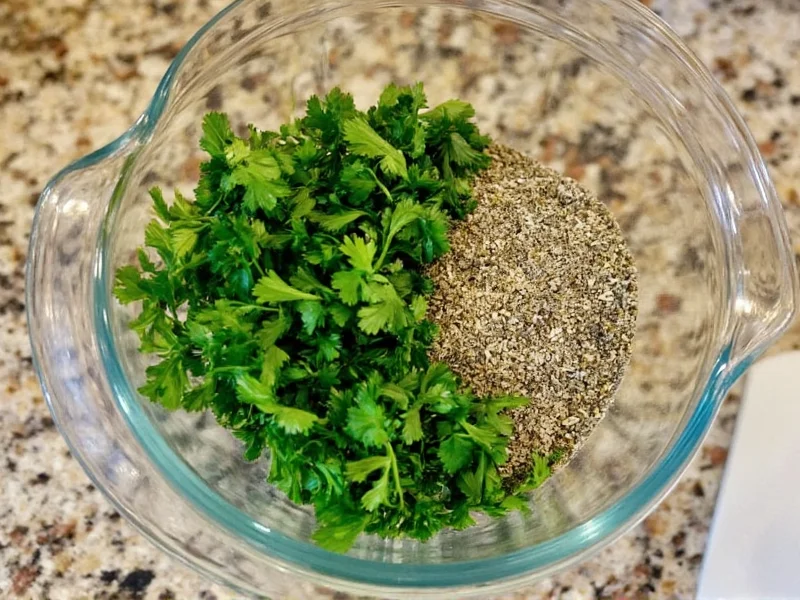When adapting recipes that call for fresh herbs to use dried alternatives, understanding precise measurement conversions is crucial for maintaining flavor balance. The standard conversion ratio between fresh and dried parsley—and most culinary herbs—is 3:1. This means 1/4 cup (4 tablespoons) of fresh parsley translates to approximately 1 to 2 tablespoons of dried parsley.
Why the 3:1 Fresh-to-Dried Herb Ratio Matters
Dried herbs contain significantly less moisture than their fresh counterparts, resulting in more concentrated flavor compounds. Fresh parsley is about 85% water, while dried parsley has most of that moisture removed during the dehydration process. This concentration means you need less dried herb to achieve similar flavor intensity.
However, the exact conversion isn't always perfectly precise. Factors like:
- Drying method (air-dried vs. oven-dried vs. commercially dehydrated)
- Storage conditions and age of dried herbs
- Specific parsley variety (curly vs. flat-leaf)
- Recipe cooking time and method
can all influence the ideal substitution amount. That's why professional chefs often recommend starting with the lower end of the conversion range (1 tablespoon dried for 1/4 cup fresh) and adjusting to taste.
| Measurement | Fresh Parsley | Dried Parsley | Conversion Ratio |
|---|---|---|---|
| Teaspoon | 3 tsp | 1 tsp | 3:1 |
| Tablespoon | 1 tbsp | 1 tsp | 3:1 |
| Cup | 1/4 cup | 1-2 tbsp | 3:1 |
| Cup | 1 cup | 1/3 cup | 3:1 |
Practical Measurement Tips for Herb Substitutions
When converting 1/4 cup of fresh parsley to dried in your recipes, follow these professional kitchen practices:
Proper measuring technique: Always measure dried herbs by lightly spooning them into your measuring spoon rather than scooping directly from the container. Packed dried herbs can double the actual amount, leading to overpowering flavors.
Timing matters: Add dried herbs earlier in the cooking process than fresh herbs. Dried parsley needs 15-20 minutes of cooking time to rehydrate and release flavors fully, while fresh parsley is typically added in the last few minutes or used as garnish.
Freshness check: Test the potency of your dried parsley by rubbing a small amount between your fingers and smelling it. If the aroma is weak, you may need to increase the amount slightly—older dried herbs lose potency over time.
When to Adjust the Standard Conversion
While the 3:1 ratio works for most applications, certain cooking scenarios require adjustments to the standard 1/4 cup fresh parsley to dried conversion:
- Long-simmering dishes: For soups, stews, or sauces that cook for hours, use the lower end of the conversion (1 tablespoon dried for 1/4 cup fresh) as flavors continue to concentrate during extended cooking.
- Raw applications: In dishes like tabbouleh or fresh herb sauces where parsley isn't cooked, dried parsley makes a poor substitute as it won't rehydrate properly—seek alternative fresh herbs instead.
- Delicate dishes: For subtle-flavored recipes like fish or egg dishes, use 3/4 tablespoon dried parsley per 1/4 cup fresh to prevent overpowering other ingredients.
- Strong-flavored dishes: In robust recipes like chili or tomato-based sauces, you might need the full 2 tablespoons dried parsley to match the flavor impact of 1/4 cup fresh.
Avoiding Common Herb Conversion Mistakes
Many home cooks make critical errors when substituting dried for fresh parsley that compromise their dishes:
Overpacking measurements: Pressing dried herbs into measuring spoons can double the actual amount. Always use the spoon-and-level method for accuracy when converting 1/4 cup fresh parsley to dried measurement.
Ignoring herb age: Dried herbs lose potency over time. Parsley stored longer than 6 months may require up to 50% more than the standard conversion to achieve similar flavor intensity.
Misunderstanding herb types: Not all herbs follow the exact 3:1 ratio. Delicate herbs like basil and cilantro have a 2:1 ratio, while robust herbs like rosemary and thyme maintain the 3:1 ratio. Parsley falls in the middle, explaining why the conversion range is 1-2 tablespoons.
Professional Chef Recommendations
Top culinary professionals suggest these best practices when working with dried parsley substitutions:
"When converting fresh to dried herbs, I always start with the lower end of the conversion range. You can add more, but you can't take it out. For 1/4 cup fresh parsley, begin with 1 tablespoon dried, then taste after 15 minutes of cooking and adjust if needed." — Chef Michael Rodriguez, Executive Chef at The Herb Garden Restaurant
For optimal results with dried parsley:
- Crush dried parsley between your fingers before adding to release essential oils
- Add to liquids early in cooking to allow proper rehydration
- Store dried herbs in airtight containers away from light and heat
- Replace dried herbs every 6-12 months for maximum flavor impact











 浙公网安备
33010002000092号
浙公网安备
33010002000092号 浙B2-20120091-4
浙B2-20120091-4